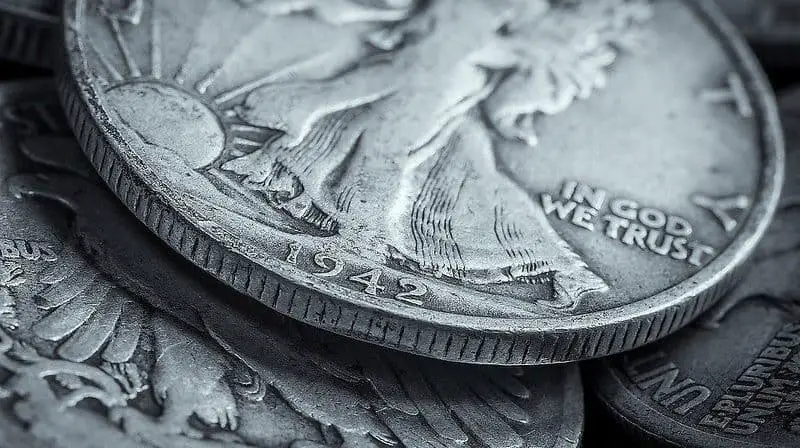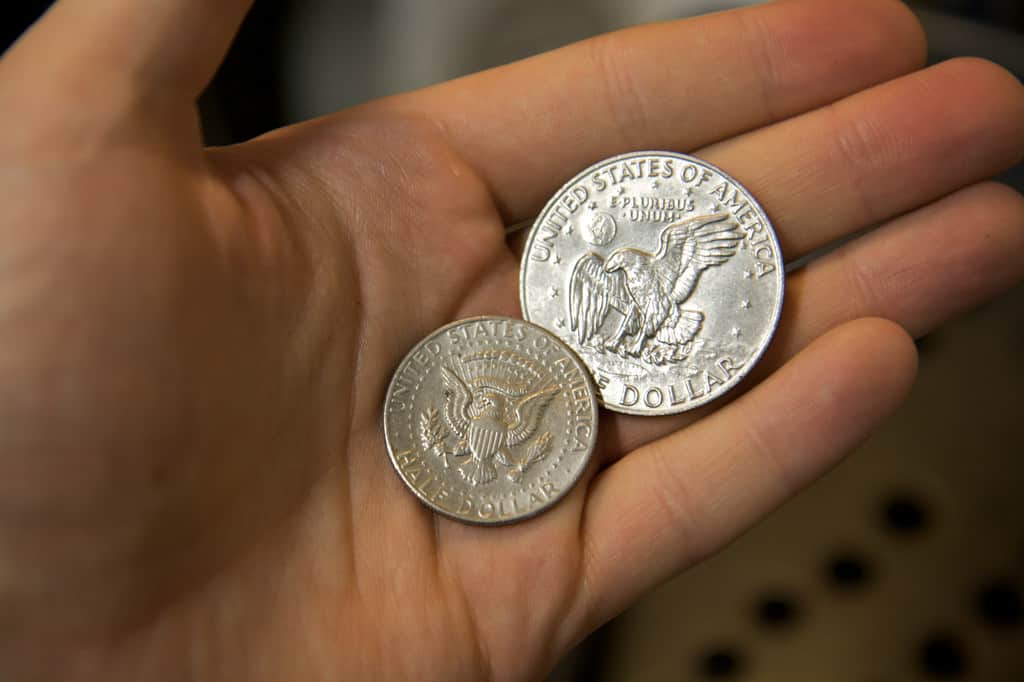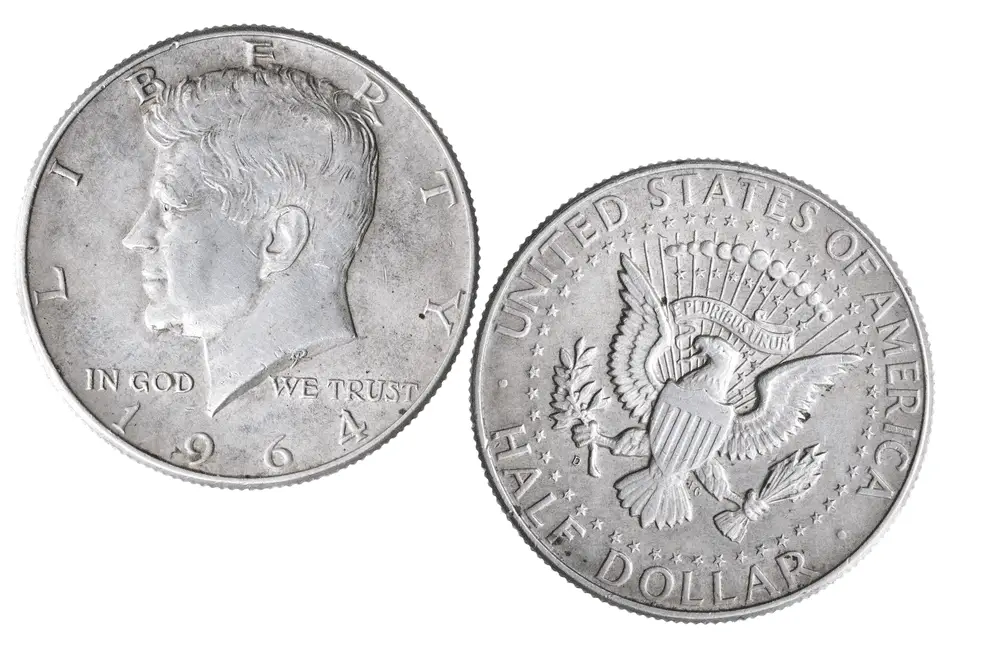Table of Contents
*This post may contain affiliate links. As an Amazon Associate we earn from qualifying purchases.
Investment in silver has been on a surge in recent years. Many investors are looking to invest in silver, but may not know how. You may remember old silver half dollars from back in your heyday, but why silver? What makes it so special?
Silver, as you may or may not know, is a precious metal with industrial uses. Often found in electronics, silver uses are exploding. Many investors are looking to diversify their portfolios with exposure to precious metals.
Many buy bullion, the bulk form of precious metals, while others seek to diversify in numismatics, collectible coins.
Numismatics are rare coin currencies that have a higher value placed on them than their face value because of historical relevance or rarity. Although precious metals are viewed as a safe haven asset, some investors turn to rare coinage to bring a level of diversification inside their precious metals portfolio. You may have been searching for answers to your investment woes and today we will get you one step closer.
To see some of the most popular silver half dollars available just click here.
What Are Silver Half Dollars?

To understand what the terms silver dollar and silver half dollar mean, we have to take a trip back to the early ages of the United States.
Today, American Silver Eagles are minted as legal tender of the United States and minted as one dollar. Silver investors commonly associate a dollar of silver as one troy ounce of silver which is 480.00 grains. This is misleading as the Coinage Act of 1792 defined the weight of a “dollar” as 371.25 grains of pure (0.999, 99.9% or three nines) fine silver or 24.75 grains of fine gold.
Throughout the history of America, the weight of gold would fluctuate due to the silver-to-gold ratio and an increase in annual gold supply brought on by the American Gold Rush. The confusion of what a dollar was comes from the public putting a price on silver in Federal Reserve Notes (referred to as dollars today). The constitution states in Article 1 Section 10 that “No State shall… Make anything but gold and silver coin a Tender in Payment of debts…”
The next question is how do you put a price on the money when money, as defined by the constitution, is gold and silver?
The Coinage Act of 1873 de-monetized silver and set the country on a gold standard although this would not officially be adopted until 1900. Due to angered Americans, silver certificates would emerge. These silver certificates were backed by a dollar of silver.
Over the next few decades, the price of silver would fall in price down to 25 cents an ounce in 1933 due to deflation and advances in mining technology that would increase the world silver supply. The Coinage Act of 1934 set the official price of an ounce of silver to $1.29.
Silver dollars (both in paper and coinage) would stay in circulation until 1965 when President Johnson eliminated silver from coinage. This was brought on due to silver stockpiles in the US Treasury having dwindled because of industries that consumed silver in their products.
After the Coinage Act of 1965, dimes and quarters minted by the US Treasury were stripped of 90% silver composition and replaced with 75% copper and 25% nickel.
Following the Coinage Act of 1965, silver half dollars dropped from 90% silver to 40% silver. 40% silver half dollars would continue to be minted through 1970. Beginning in 1971 and continuing today, silver half dollars are made of 75% copper and 25% nickel. Collector coin sets were issued containing 40% silver in 1970 and in 1976
Gresham’s law states that bad money drives out good money. When President Richard Nixon temporarily suspended the convertibility of the US Dollar into gold, this lead to speculation and many wise investors took silver coinage out of circulation.
It wouldn’t be until 1975 when the United States Government lifted the ban on gold priced at around $175/ounce which lead to the subsequent $850/ounce run up in 1980.
Silver Half Dollar Values
If you’ve followed along this far, you’re doing well. Let’s get into how silver dollars and silver half dollars are valued.
Silver dollar prices have fluctuated due to the pricing of federal reserve notes, often referred to as dollars today. A price is a unit of account attributed to a particular good or service; value is what you can get with those goods or services. The value of a silver dollar is not in its price, but in the composition of metal that it has.
Many often erroneously associate these prices with value. The price of silver half dollars vary based on their grade/condition, mintage, and demand.

Grade and condition
Do you believe you stumbled upon a few rare silver half dollars? Have you had them checked for grade/condition by an accredited coin appraiser? This is the first step if you happened to be in your grandfather’s attic and were blessed to find some potentially rare coins.
The condition of the coin increases its price. Circulated (common) coins could go anywhere from its melt value to a couple thousand. Not bad if you’re looking at the upside. Uncirculated coins, those with no evidence of wear or marks, start from a few dollars over melt value to tens of thousands of dollars.
Mintage
Mintage will tell you how many particular silver half dollars were minted. Start by locating the year and the mint in which it was produced. Mintmarks can be found on either side of the coin depending on the date. These mintmarks are a letter denoting in which city they were minted.
The cities include Philadelphia (no mark or P), Denver (D), and San Francisco (S). It’s easy research to find out how many of the coins you’re holding were made as that can leave a clue to its rarity.
Demand
Demand for the coin is another factor. For example, if you came across some silver half dollars with common dates and not a rare one, people will typically pay you for the melt value plus premium at the time for the coin.
Demand can only drive up the price. Some coins may be poorer in quality but the demand for them could drive up their price.
Rarity & Availability
There are many coins that numismatic coin collectors seek today. Unless passed down through generations, the chances of stumbling across one of these coins would ultimately boil down to luck.
Many of these silver half dollars listed below have stood the test of time, with their availability dwindling over the years to come.
Here is a list of some of the rarest silver half dollars to date:
Flowing Hair Early Half Dollars
The Flowing Hair Half Dollar is the oldest minted half dollar coin in the United States. Part of the Bust half dollar family, this coin was minted from 1794 to 1795 with 1,758 and 160,295 minted, respectively. It has a price range of $4,500-$75,000.
Draped Bust Half Dollars
This coin is the second oldest minted coin in America with an average circulated price of $7,500-$25,000. These coins were minted from 1796 to 1807. In 1999, A Class I, Watters-Childs Specimen sold for $4.14 million. All strikes are considered rare.
Capped Bust Half Dollars
Another strike of the Bust half dollar family, this coin was minted form 1807-1839. Circulated coins $20-$50 and $300-$30,000. (Rare dates: 1815; Scarce dates: 1807-1817)
Seated Half Dollars
Seated half dollars or the Seated Liberty Half Dollar was minted from 1839 to 1891. These coins range from $20-$1,000 with coins in excellent condition going for more. The most sought-after coins of this strike are ones minted around the civil war as these are important in American history. (Rare dates are 1850, 1851, 1852, 1855-S, 1870-CC, 1871-CC, 1874-CC, 1878-CC, 1878-S, 1879-1890. There are many scarce dates)
Barber Half Dollars
Barber half dollars (or Liberty Head half dollars) were minted from 1892 until 1915. These coins go for $7-$25 circulated and as much as $500 uncirculated. (Rare dates include: 1892-O, 1892-S, 1893-S, 1896-S, 1897-O, 1897-S. Scarce dates: 1892-1899, 1901-S, 1904-S, 1913, 1914, 1915)
Walking Liberty Half Dollars
Struck from 1916 to 1947, the Walking Liberty half dollar has a price range from $7-$1,000 and some rare years have reached upwards of $8,000. (Rare dates: 1916-S, 1921, 1921-D. Scarce dates: 1916-1933, 1938-D)
Common Silver Half Dollars
Next, we’ll round out our description of silver half dollars with what are currently designated common coins.
Franklin Half Dollar
The Franklin half dollar is a common silver half dollar that is easily recognizable by the image of Benjamin Franklin on the front. Minted from 1948 to 1963, this coin has little numismatic value and bought at a small premium above its melt value.
Kennedy Half Dollar
The Kennedy half dollar was created to commemorate the late President John F. Kennedy in 1964. There are no rare dates associated with this coin although 12 Special Mint Strike (SMS) 1964 Kennedy half dollars were created. One sold for just under $50,000.
Conclusion
Diversifying in numismatics can be fun and exciting knowing you are holding on to a piece of history, but do so with caution. When looking to invest in numismatics, beware of scams online. Many will advertise fake coins hoping to get over on new-coming precious metals investors. To avoid this, be sure to research and find reputable dealers that specialize in numismatics.
Many dealers will answer your questions as they are excited to share their expertise to help you along your investing journey.
Don’t forget that there are hundreds of articles and resources online regarding numismatics well worth your attention and time. I hope this gave you a little insight and confidence in investing in precious metals. Good fortune and happy (coin) hunting.

